The Origin of Christmas
by Bob Brooke
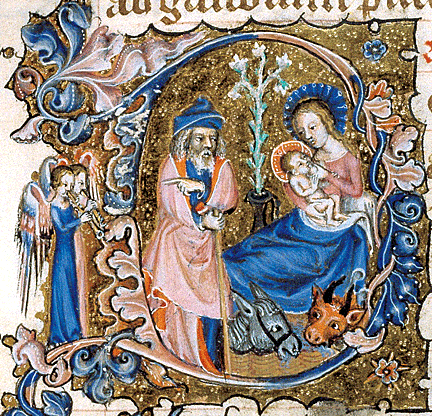 The
first recorded incidence of Christmas being celebrated actually dates
all the way back to Rome on December 25, 336, during the time of the
Roman Emperor Constantine. So it seems the Romans invented it, although
there’s no specific person credited with having done so. The
first recorded incidence of Christmas being celebrated actually dates
all the way back to Rome on December 25, 336, during the time of the
Roman Emperor Constantine. So it seems the Romans invented it, although
there’s no specific person credited with having done so.
The
nativity sequences included in the Gospels of Matthew and Luke prompted
early Christian writers to suggest various dates for the anniversary.
Although the gospels don’t indicate a date, early Christians connected
Jesus to the Sun through the use of such phrases as "Sun of
Righteousness." The Romans marked the winter solstice on December 25.
Around AD 200, Clement of Alexandria wrote there were several reasons
for choosing December 25 as a date of celebration. It was the date of
the winter solstice on the Roman calendar—dies solis invicti nati
(“day of the birth of the unconquered sun”)—and it was nine months after
March 25, the date of the vernal equinox and a date linked to the
conception of Jesus celebrated as the Feast of the Annunciation. In this
way, he tried to make sense of the birth since a woman’s pregnancy
usually lasts for nine months.
Despite the Romans having marked the date, Christmas was a relatively
minor affair, which the Church didn’t celebrate with a specific liturgy
until the 9th century, but it didn’t attain the liturgical importance of
either Good Friday or Easter, the other two major Christian holidays
until much later.
Centuries before the arrival of the man called Jesus, early Europeans
celebrated light and birth in the darkest days of winter. Many peoples
rejoiced during the winter solstice, when the worst of the winter was
behind them, and they could look forward to longer days and extended
hours of sunlight.
 But
in Rome, where winters weren’t as harsh as those in the far north,
people celebrated Saturnalia, a holiday in honor of Saturn, the god of
agriculture. Beginning in the week leading up to the winter solstice and
continuing for a full month, Saturnalia was a hedonistic time, when food
and drink were plentiful and the normal Roman social order was turned
upside down. For a month, the Romans temporarily freed their slaves,
treating them as equals. Business and schools closed so that everyone
could participate in the holiday's festivities. But
in Rome, where winters weren’t as harsh as those in the far north,
people celebrated Saturnalia, a holiday in honor of Saturn, the god of
agriculture. Beginning in the week leading up to the winter solstice and
continuing for a full month, Saturnalia was a hedonistic time, when food
and drink were plentiful and the normal Roman social order was turned
upside down. For a month, the Romans temporarily freed their slaves,
treating them as equals. Business and schools closed so that everyone
could participate in the holiday's festivities.
Also
around the time of the winter solstice, Romans observed Juvenalia, a
feast honoring the children of Rome. In addition, members of the upper
classes often celebrated the birthday of Mithra, the god of the
unconquerable sun, on December 25. It was believed that Mithra, an
infant god, was born of a rock. For some Romans, Mithra’s birthday was
the most sacred day of the year.
The
end of December was also a perfect time for celebration in most areas of
Europe. At that time of year, farmers had slaughtered most cattle and
pigs, so they wouldn’t need to be fed during the winter. For many, it
was the only time of year when they had a supply of fresh meat. In
addition, most wine and beer made during the year had finally fermented
and was ready for drinking.
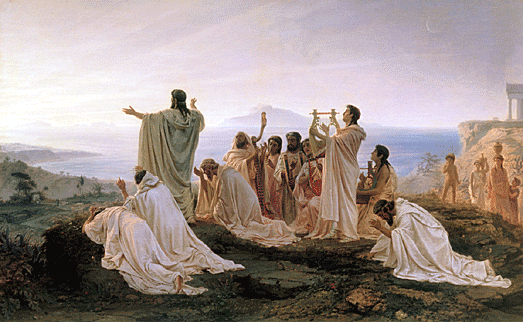
By celebrating Christmas at the same time as traditional winter solstice
festivals, church leaders hoped that Christmas would be embraced by the
public but gave up dictating how people should celebrate it. By the
Middle Ages, Christianity had, for the most part, replaced pagan
religions. On Christmas, believers attended church, then celebrated
raucously in a drunken, carnival-like atmosphere similar to today’s
Mardi Gras. Each year, a beggar or student would be crowned the “lord of
misrule” and eager celebrants played the part of his subjects. The
celebrations tended to be riotous, with binge-drinking, gluttony and
other hedonism involved, and celebrants often going from door to door
threatening vandalism if homeowners didn’t give them food and drink.
Thus, Christmas became the time of year when the upper classes could
repay their real or imagined “debt” to society by entertaining less
fortunate citizens.
In
the Early Middle Ages, the Epiphany, which in western Christianity
focused on the visit of the three kings, overshadowed Christmas Day. But
the medieval calendar was dominated by Christmas-related holidays. The
40 days before Christmas became the "Forty Days of St. Martin,” which
began on November 11, the feast of St. Martin of Tours), now known as
Advent. In what was later to become Italy, people attached former
Saturnalian traditions to Advent. Around the 12th century, these
traditions transferred again to the Twelve Days of Christmas—lasting
from December 25 to January 5—a time that appears in the liturgical
calendars as Christmastide or Twelve Holy Days.
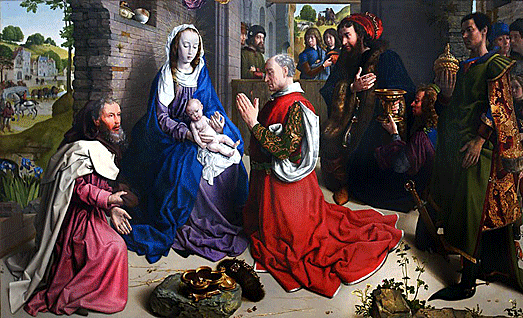
The coronation of Charlemagne on Christmas of 800 helped promote the
popularity of the holiday.
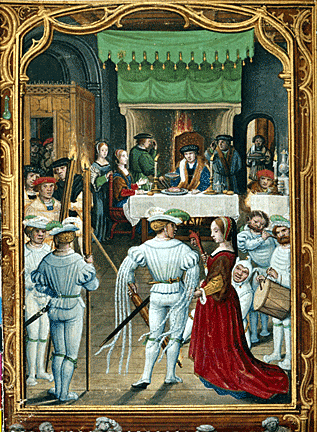 By
the High Middle Ages, the holiday had become so prominent that
chroniclers routinely noted where various magnates celebrated Christmas.
King Richard II of England hosted a Christmas feast in 1377 at which
guests ate 28 oxen and 300 sheep. The Yule boar was a common feature of
medieval Christmas feasts. Caroling also became popular and was
originally performed by a group of dancers who sang, consisting of a
lead singer and a ring of dancers that provided the chorus. Various
writers of the time condemned caroling as lewd, indicating that the
unruly traditions of Saturnalia and Yule may have continued in this
form. "Misrule"—drunkenness, promiscuity, gambling—was also an important
aspect of the festival. In England, people exchanged gifts on New Year's
Day and drank a special Christmas ale. By
the High Middle Ages, the holiday had become so prominent that
chroniclers routinely noted where various magnates celebrated Christmas.
King Richard II of England hosted a Christmas feast in 1377 at which
guests ate 28 oxen and 300 sheep. The Yule boar was a common feature of
medieval Christmas feasts. Caroling also became popular and was
originally performed by a group of dancers who sang, consisting of a
lead singer and a ring of dancers that provided the chorus. Various
writers of the time condemned caroling as lewd, indicating that the
unruly traditions of Saturnalia and Yule may have continued in this
form. "Misrule"—drunkenness, promiscuity, gambling—was also an important
aspect of the festival. In England, people exchanged gifts on New Year's
Day and drank a special Christmas ale.
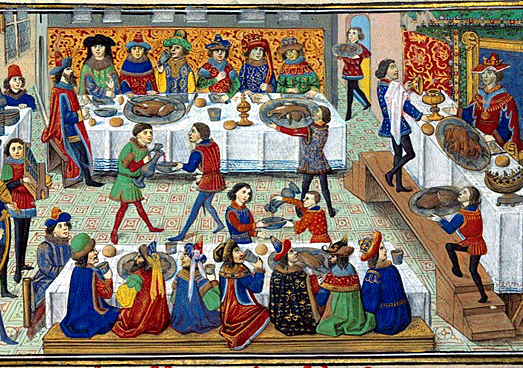
Christmas during the Middle Ages was a public festival that incorporated
ivy, holly, and other evergreens. Gift-giving usually occurred between
people with legal relationships, such as tenant and landlord. The annual
indulgence in eating, dancing, singing, sporting, and card playing
escalated in England, and by the 17th century the Christmas season
featured lavish dinners, elaborate masques, and pageants.
In 1607, King James I insisted that a play be acted on Christmas night
and that the court indulge in games. It was during the Reformation in
16th- and 17th-century Europe that many Protestants changed the gift
bringer to the Christ Child or Christkindl, and the date of giving gifts
changed from December 6 to Christmas Eve.
Charles Dickens presented Christmas in its more modern form in his
classic novel, A Christmas Carol. Published in 1843, it became an
instant best-seller and changed people’s view of Christmas to a time of
kindness and charitable acts and a time for families to be together.
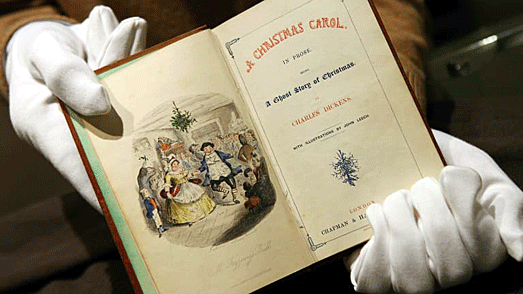
The Victorians took his view of the festive season to their hearts, with
new traditions such as Christmas trees----introduced by Queen Victoria’s
husband Prince Albert— Christmas cards and gift-giving replaced the
excesses of old.
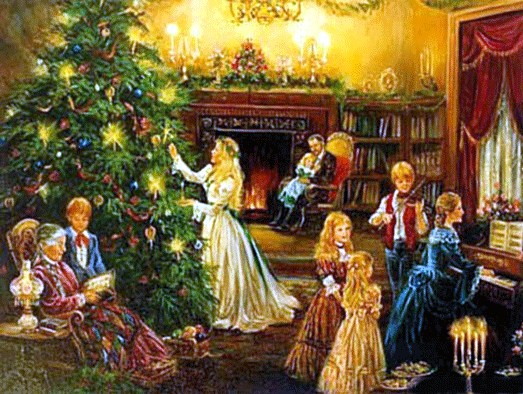
<
More Special Features
Next Article > |
